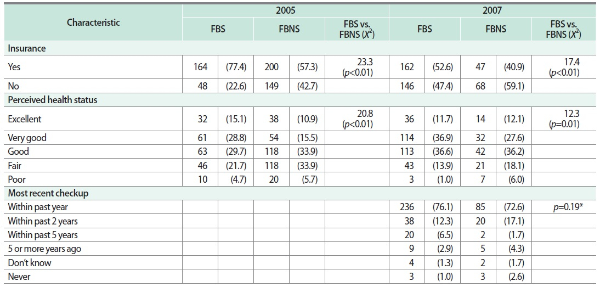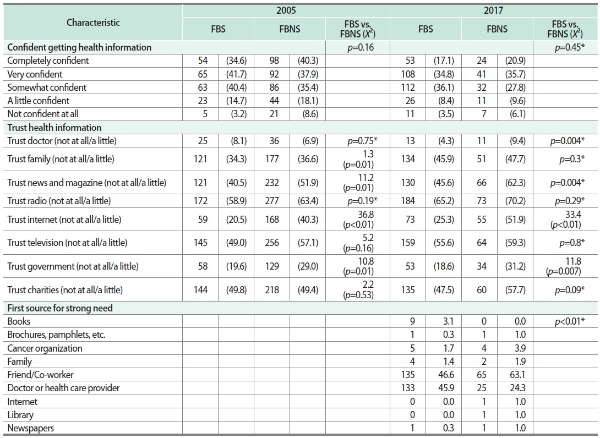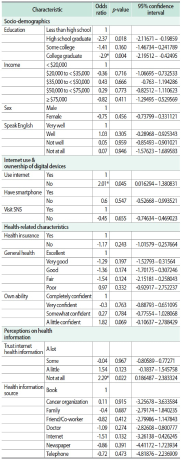1. INTRODUCTION
The exponential growth of the Internet allows health consumers to find volumes of health information in a fast and convenient way. At the same time, health consumers are now expected to be proactive in seeking medical information, independently managing their health care, and participating in health/medical decision-making (Alpay, Verhoef, Xie, Te’eni, & Zwetsloot-Schonk, 2009). Despite the expectation for health consumers’ active engagement in information seeking, it is known that some people do not seek health information. According to the Health Information National Trends Survey (HINTS) 2017, 19.6% of United States (U.S.) adults had never looked for information about health or medical topics from any source. Among cancer survivors surveyed in HINTS 2013, about 20% had never looked for cancer-related information (Rutten, Squiers, & Hesse, 2006).
The question of who does not seek health information is crucial as it is related to the deep divides among different racial/ethnic groups as well as between higher and lower socioeconomic groups (Ramanadhan & Viswanath, 2006). Johnson and Case (2012) revealed that the typical profile of a high information seeker is a white, middle-aged woman with high socio-economic status and a high level of education. Reduced access to health information results in gaps in health knowledge and widening health disparities (Ramanadhan & Viswanath, 2006). Therefore, it is important to understand the characteristics of non-seekers of health information among the foreign-born population, who are perceived as an underserved population in health care, in order to devise a customized intervention for them and to remove health disparities.
The purpose of this study is to develop a profile of non-seekers of health information among the U.S. foreign-born population, and identify potential predictors of their non-seeking behavior. More specific research questions that guide this study are as follows:
-
• RQ1. How do the foreign-born population who do not seek health information differ from those who do seek health information?
-
• RQ2. Are there changes in the profiles of foreign-born health information non-seekers over the past 12 years?
-
• RQ3. What are the predictors of foreign-born populations who do not seek health information?
2. LITERATURE REVIEW
2.1. Predictors of Health Information Seeking
Previous research identified a wide variety of factors associated with health information seeking, for example, socio-demographic characteristics, health/disease status, and Internet access.
In terms of socio-demographic characteristics, females tend to seek health information more actively than males (Atkinson, Saperstein, & Pleis, 2009; Fox & Jones, 2009), consulting more types of information (Rowley, Johnson, & Sbaffi, 2017). Younger age is also associated with health information seeking in general (Ramanadhan & Viswanath, 2006; Tennant et al., 2015), and particularly on the Internet (Lee, Boden-Albala, Larson, Wilcox, & Bakken, 2014; Nikoloudakis et al., 2016). However, Kim and Kwon (2010) found that cancer e-patients tend to be older than those without cancer because the possibility of getting cancer increases with age. Income and education are consistently reported as predictors of health information seeking: Those with higher income and education tend to seek more health information and use a broader range of information sources than those with lower income and education (Ramanadhan & Viswanath, 2006; Tennant et al., 2015).
Among health-related factors, having a health/medical problem is a strong driver of health or cancer information seeking (Goldner, 2006; Kim, 2015; Rutten et al., 2006). In a Pew Internet and American Life Project survey report (Fox, 2011), about half of Internet users answered that they did not search for health information because they had no health/medical issue at hand. In the same vein, Arora et al. (2008) found that those with a personal cancer history and those with a family history only are more likely to seek cancer information. However, contradictory findings also exist. A large number of people diagnosed with diseases intentionally avoid health information to prevent negative emotions (Rees & Bath, 2001).
Previous research shows that Internet usage and other Internet activities were associated with online health information seeking (Kim, 2015). However, Li, Theng, and Foo (2016) found that the impact of Internet usage on online health information seeking decreased significantly from 2002 to 2012. They suspected that as the Internet becomes more prevailing among the general public, overall Internet usage may suffer from a decreased correlation with the search for health information online.
2.2. Foreign-Born Population Health Information Seeking
Although health information has been considered a way of facilitating positive health behaviors and alleviating health disparities among immigrants (Clayman, Manganello, Viswanath, Hesse, & Arora, 2010; Richardson, Allen, Xiao, & Vallone, 2012), health information disparities are present for immigrants. Using HINTS data, Yoon (2014, using HINTS 2013) and Zhao (2010, using HINTS 2005) demonstrated that foreign-born populations, compared to their U.S.- born counterparts, have fewer health information seeking experiences, less trust in health information, and less confidence in obtaining health information. Yoon, Huang, and Kim (2017), who investigated ten years of trends in health information seeking behaviors of the U.S. foreign-born population using HINTS data, found that the percentage of foreign-born respondents who sought health information increased from 38% to 70% between 2005 and 2014; however, compared to the U.S.-born population of whom 84% reported health information seeking experiences in 2014, the foreign-born population still faced persistent disparities in accessing and using health information.
Jang, Yoon, and Park (2018) analyzed the use of health information resources based on the data collected from Asian Americans aged 18 and older living in Austin, Texas. The result shows that Asian Americans who have relatively good health-related indicators (higher insurance, lower unmet healthcare needs, and better self-reported health status) tend to seek health information more. However, those with lower access to health information have relatively lower education levels, limited English proficiency, and higher percentages of living in the U.S. less than ten years. Lee et al. (2014) examined factors associated with health information seeking behaviors of Hispanics living in New York City. They found more active online health information seeking behaviors from respondents who were female, younger, married, highly educated, and highly computer literate, as well as those who were in worse health status or had serious health problems.
Although there have been studies analyzing factors related to health information seeking behaviors and examining the foreign-born population’s health information behaviors, there is a lack of research on health information non-seekers among foreign-born members, who are particularly perceived as an underserved population in health care. The current study will focus on a profile of non-seekers of health information among the U.S. foreign-born population, and identify potential predictors of their non-seeking behavior.
3. METHODOLOGIES
The HINTS is a cross-sectional national survey, launched by the Health Communication and Informatics Research Branch of the Division of Cancer Control and Population Sciences of the National Cancer Institute. The HINTS 1 dataset was released in 2003, and currently HINTS 5 datasets are published at http://hints.cancer.gov. Although HINTS was initiated with an emphasis on cancer information communication for its prevention, the survey questionnaires were designed to answer broad perspectives of health communication. This study analyzed HINTS 5 Cycle 1 (2017) data. Data collection for HINTS 5 (Cycle 1) was conducted from January 25 through May 5, 2017, and survey responses numbered 3,335 (Westat, 2017).
All statistical analyses were conducted using STATA 10.1 software. The percentage distribution of all variables across health information non-seekers was examined. Logistic regression, the Chi-squared test, and/or the Fisher’s exact test were performed to answer the research questions. Among them, Chi-squared test was applied for a pair-wise comparison between two variables and to see if there is a significant difference among their frequencies. And, the Fisher’s exact test was used when the sample size is small (e.g., n<10). Logistic regression was also used to describe data and to explain the relationship between one dependent binary variable (e.g., foreign-born seeker [FBS]/foreign-born non-seekers [FBNS]) and multiple independent variables. It can identify which variable is significantly associated with the outcome of the binary variable. From the HINTS 5 Cycle 1 survey questionnaire, the authors selected the questions which belong to the four categories, demographic, Internet use & ownership of digital devices, health-related characteristics, and perceptions on health information. These categories have been identified as factors related to health information behaviors in previous studies. Table 1 shows a list of HINTS questions whose answers were analysed in this study.
4. RESULTS
Related to the question “Have you ever looked for information about health or medical topics from any source?”, 73.0% of the foreign-born respondents in the 2017 dataset reported seeking health information at least once (Table 2). This is an enormous increase from 2005,1 when only 38.0% reported having health information-seeking experience. The U.S.-born respondents showed a similar pattern: 86.0% in 2017, and 55.0% in 2005. Despite the rising rate of health information seeking among the foreign-born respondents, the foreign-born population were persistently and significantly less likely to seek health information than U.S.-born respondents were (p<0.01 for both 2005 and 2017). In the 2017 dataset, 27.0% are health information nonseekers among foreign-born, and 14% are non-seekers among U.S.-born.
Table 2.
Heath information-seeking experiences
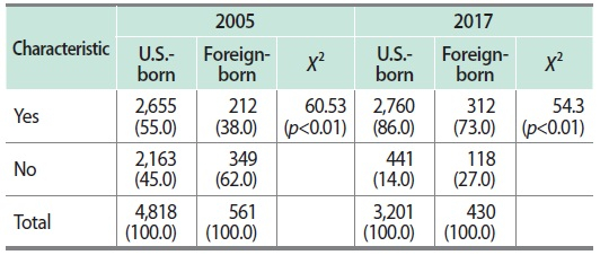
Values are presented as number (%).
U.S., United States.
4.1. Bivariate Analysis
The profile of the FBNS was examined by comparing FBS in terms of four categories: demographic characteristics, access to online environments, health-related characteristics, and perceptions on health information. The changes from 2005 (or 2007, if 2005 data is not available for the variable) to 2017 were analyzed using a bivariate analysis (p < 0.05).
Table 3 presents socio-demographic characteristics of FBNS. First, the profile of the FBNS was examined by comparing them with FBS using the 2017 dataset. Among various socioeconomic and demographic characteristics, a series of Chi-square tests revealed that the two groups are significantly different in education, annual household income, sex, and speaking English. Compared to FBS, FBNS tend to be male, have fewer years of education, and have less annual house income. Also, fewer people answered that their English speaking ability is very well. Second, the profile of FBNS obtained from the 2017 dataset was compared with that from 2005. In both 2005 and 2017 datasets, significant differences between FBS and FBNS were noted in education, annual household income, and sex. However, race/ethnicity and age were significant variables in the 2005 dataset, but not in the 2017 dataset.
Table 3.
Comparative characteristics of FBNS for socio-demographic characteristics

Values are presented as unweighted number (weighted %).
FBS, foreign-born seeker; FBNS, foreign-born non-seekers.
*Fisher’s test; others are Chi-square.
Table 4 demonstrates the use of Internet, digital device ownership, places of using Internet, and social media use. In the 2017 dataset, the three variables, use of Internet, use of social media, and ownership of digital device (tablet, smartphone, cellphone), showed significant differences between FBS and FBNS. FBNS have lower use of Internet and social media, and lower ownership of digital device. In particular, the percentage of FBNS who never used the Internet (49.2%) is two times higher than that of FBS (21.9%). However, the places of accessing the Internet variable, which showed a significant difference in the 2005 dataset, were not significant in the 2017 dataset.
Table 4.
Comparative characteristics of FBNS for online use
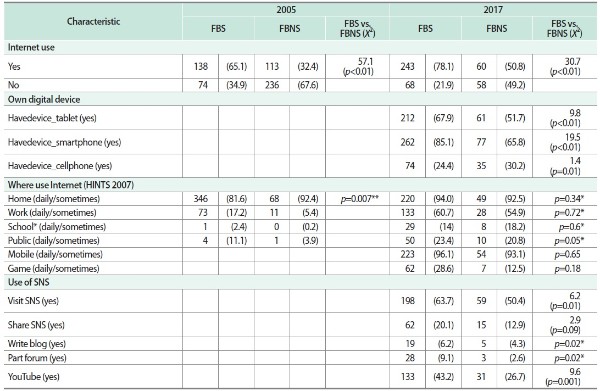
Values are presented as unweighted number (weighted %).
FBNS, foreign-born non-seekers; FBS, foreign-born seeker; HINTS, Health Information National Trends Survey; SNS, social network service.
*Fisher’s test; others are Chi-square.
** HINTS 2007 was used instead of HINTS 2005, since the question was not clearly asked in 2005. HINTS 2007 asked to select a type (“Home,” “Work,” “School,” “Public” …), not separately asking how often going to “Home.” Therefore, results are aggregated to do one Fisher exact test (some cell values < 20).
Table 5 presents ownership of health insurance, self-perceived health status, ability to take care of health, and healthy lifestyles (recent checkups and physical exercise) of FBNS. First, when comparing FBS and FBNS using the 2017 dataset, there were statistically significant differences in ownership of health insurance, self-perceived health status, and ability to take care of health. Compared to FBS, FBNS tend to have lower ownership of health insurance, lower self-perceived health status, and lower self-perceived ability to take care of health. No statistically significant difference was found in healthy lifestyles. The same pattern was found in the 2005 or 2007 dataset (HINTS 2007 was used for physical exercise, and HINTS 2005/2007 were not available for most recent checkups).
Table 5.
Continued

Values are presented as number (%).
FBS, foreign-born seeker; FBNS, foreign-born non-seekers.
*Fisher’s test; others are Chi-square.
As shown in Table 6, there is no significant difference between FBS and FBNS in their perceptions on confidence in getting health information, both in the 2005 and 2017 datasets. Regarding trust in health information sources in the 2017 dataset, FBNS showed a significantly lower trust in health information sources such as Doctor, News and Magazine, Internet, and Government. The 2005 dataset showed a significant difference with Family, instead of Doctor.
4.2. Multivariate Analysis
The variables that showed significant bivariate differences were further examined through a logistic regression. The test results revealed three predictors of foreign-born health information non-seekers: education, Internet use, and trust in Internet health information (Table 7). In other words, FBNS have fewer college degrees (odds ratio [OR]=-2.9), never used the Internet (OR=2.01) or have lower trust in Internet health information.
5. DISCUSSION AND CONCLUSION
Although more and more people look for health information, disparities in accessing and using health information between U.S.-born and foreign-born populations still exist. According to the 2017 HINTS dataset, the percentage of non-seekers among the foreign-born population (27.0%) is almost twice as much as that of the U.S.-born population (14.0%) (Table 2). For the purpose of investigating profiles of FBNS, this study analyzed the characteristics of FBNS using HINTS 2005 and 2017 datasets by four categories: demographic features, Internet use/ownership of digital devices, health-related characteristics, and perceptions on health information. From the 2017 dataset, the following variables presenting differences between FBNS and FBS were identified: education, income, sex, English proficiency, uses of Internet and social media, ownership of digital devices, ownership of health insurance, health status, ability to take care of health, and level of trust in health information sources. Among these variables, education, use of the Internet, and trust in Internet health information were identified as predictors of health information non-seekers among the foreign-born population.
The identified variables have often been addressed in previous studies as characteristics of disadvantaged people in accessing and utilizing health information (Selsky, Luta, Noone, Huerta, & Mandelblatt, 2013; Shin & Maupome, 2017; Thomson & Hoffman-Goetz, 2009; Todd & Hoffman-Goetz, 2011; Vahabi, 2011; Wang & Yu, 2015; Yoon, 2014; Yoon & Kim, 2014; Zhao, 2010). This indicates that while the foreign-born population as a whole is considered disadvantaged compared to the U.S.-born population, even within the foreign-born population, more disadvantaged groups are less likely to seek health information.
Among the three predictors, education has been a consistently strong predictor of health information seeking. Viswanath and Ackerson (2011) state that education may provide health information seekers with skills, knowledge, and confidence to seek health information they need, emphasizing the educational background in health information seeking. Related to Internet use, it is notable that over half of FBNS never used the Internet while only 22% of FBS did not (Table 4). Although it may hold true for the general public that the widespread of the Internet has decreased the association between Internet activities and online health information seeking (Li et al., 2016), in the foreign-born community where the Internet is relatively less prevalent, the use of the Internet might be still a critical factor affecting health information seeking. In terms of trust, individuals with lower trust in Internet health information are less likely to seek information. Given that the increased use of the Internet can foster familiarity with and trust in the Internet, it would be helpful to provide FBNS with health literacy instruction including technology literacy in the health context (Kim, 2015).
Moreover, through the comparison of the 2005 and 2017 datasets, this study provided some insights on the trends of FBNS characteristics. The bivariate analysis results revealed that three variables - race/ethnicity, age, and place of accessing the Internet - which were identified as significant factors in the 2005 dataset, were no longer significant in the 2017 dataset. Recent studies report that the widespread use of smartphones has decreased the gaps of Internet accessibility, particularly among ethnic minorities and aged populations (Anderson & Perrin, 2017; Perrin & Turner, 2019). Also, in this study a significant difference was observed in smartphone ownership between FBNS (65.8%) and FBS (85.1%) (Table 4). It is suspected that the dominant use of mobile devices not only removes the importance of where to access the Internet, but reduces the Internet accessibility gaps among different races and age groups. More generally speaking, the proliferation of smartphones might have contributed to increasing the foreign-born population’s health information seeking experiences.
This study paid attention to FBNS’ health information seeking, based on the premise that health information would make positive influences on reducing health disparities. Although this study was able to describe the characteristics of FBNS and identify predictors of their health information non-seeking, it has the limitation of using secondary data that does not explain why they do not seek health information. For example, this study demonstrated that low trust in Internet health information is one of the predictors of FBNS, but it did not discover whether FBNS intentionally avoid seeking health information, or if they do not have the ability to find online health information of interest. With deeper understanding of FBNS in future research, it would be possible to design better interventions for enhancing health information utilization for FBNS.
References
Tech adoption climbs among older adults. (, ) ((2017), Retrieved September 1, 2019) Pew Research Center Anderson, M., & Perrin, A. (2017). Tech adoption climbs among older adults. Pew Research Center. Retrieved September 1, 2019 from https://www.pewinternet.org/2017/05/17/techadoption-climbs-among-older-adults. , from https://www.pewinternet.org/2017/05/17/techadoption-climbs-among-older-adults
Who doesn’t gather health information online? () ((2011), Retrieved September 1, 2019) Pew Research Center Fox, S. (2011). Who doesn’t gather health information online? Pew Research Center. Retrieved September 1, 2019 from https://www.pewinternet.org/2011/10/18/who-doesntgather-health-information-online. , from https://www.pewinternet.org/2011/10/18/who-doesntgather-health-information-online
The social life of health information: Pew Internet & American Life Project 2009. (, ) ((2009), Retrieved September 1, 2019) Pew Research Center Fox, S., & Jones, S. (2009). The social life of health information: Pew Internet & American Life Project 2009. Pew Research Center. Retrieved September 1, 2019 from https://www.pewresearch.org/internet/2009/06/11/the-social-life-ofhealth-information. , from https://www.pewresearch.org/internet/2009/06/11/the-social-life-ofhealth-information
Smartphones help blacks, Hispanics bridge some – but not all – digital gaps with whites. (, ) ((2019), Retrieved September 1, 2019) Pew Research Center Perrin, A., & Turner, E. (2019). Smartphones help blacks, Hispanics bridge some – but not all – digital gaps with whites. Pew Research Center. Retrieved September 1, 2019 from https://www.pewresearch.org/fact-tank/2019/08/20/smartphones-help-blacks-hispanics-bridge-some-but-notall-digital-gaps-with-whites. , from https://www.pewresearch.org/fact-tank/2019/08/20/smartphones-help-blacks-hispanics-bridge-some-but-notall-digital-gaps-with-whites
Health Information National Trends Survey 5 (HINTS 5). Cycle 1: Methodology report. (Westat) ((2017), Retrieved September 1, 2019) Westat (2017). Health Information National Trends Survey 5 (HINTS 5). Cycle 1: Methodology report. Retrieved September 1, 2019 from https://hints.cancer.gov/docs/methodologyreports/HINTS5_Cycle_1_Methodology_Rpt.pdf. , from https://hints.cancer.gov/docs/methodologyreports/HINTS5_Cycle_1_Methodology_Rpt.pdf

